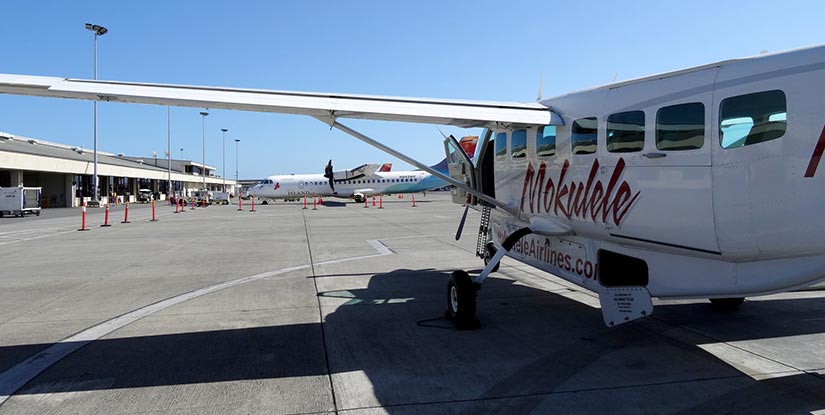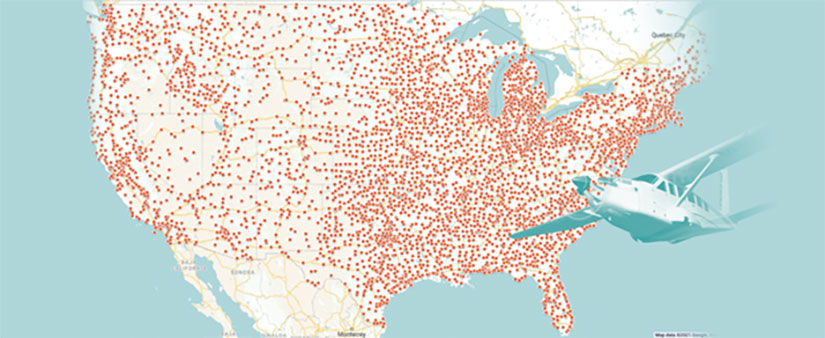Connecting the Country: Are Quick, Electrified Flights From Local Airports Possible?
NREL Models Power Requirements for Regional Air Mobility

Trick question: What is your nearest airport? You might think of the urban hub you always catch flights from, even if that airport is hours away.
But likely, it is another of the United States' more than 5,000 airports—perhaps you will pass it on the way to your next flight. These overlooked and underused regional and local airports that dot the United States may soon service your travels, thanks to advances in sustainable aviation and a nationwide, cross-sector effort.
NASA is collaborating with research institutions like the National Renewable Energy Laboratory (NREL) and companies within the aerospace and electric industries to study regional air mobility, an effort to make the most of U.S. airport infrastructure for quick and clean aerial commutes. The idea behind regional air mobility recognizes that electric and hybrid aircrafts could have a competitive edge for shorter flights, and with energy investments in the air, now is the time to make plans on the ground for the future of airports. NREL is helping with that by evaluating the technical feasibility of routing flights regionally and estimating the grid and local impacts of delivering high-speed charging to electrified airplanes.

Linking Two Transit Pathways: Aviation and Electrification
Regional air mobility unites a mix of perspectives from manufacturers, operators, airports, and utilities. Such all-hands input is reserved for deeply transformational innovation, like what is underway in mobility and energy systems. NREL's expertise will allow these sectors to understand their overlap using integrated analysis and to find solutions that help all stakeholders.
"As we've seen on the ground, energy delivery and transportation demand needs are converging," said NREL Project Manager Scott Cary, who leads the sustainable aviation research initiative for the laboratory. "Our analysis will provide clarity to all partners—this is about moving forward together with both energy and transportation demand in harmony."
An important piece in the regional air mobility is the link between the electrical and transportation system: Switching to electrified aircraft requires a significant increase in the supply of electricity at airports. How that happens exactly—whether from on-site renewables or grid supplied—is a site-by-site discussion. Transit hubs are already having that cross-sector conversation as part of the Department of Energy-led Athena project, in which airports are preparing to decarbonize and accommodate new technologies like automated and electric vehicles. Regional air mobility continues the conversation to include electrified (and maybe automated) aircraft.
"NREL is always a meeting ground for industry; we have the capabilities to provide a common stakeholder space at the intersection of energy and transportation. In the case of an innovation like electrified aviation, which has the potential to be so transformative across our land and airspace, early coordination reduces risk of entry into this emerging market," Cary said.
Turning Flight Demand Into Charging Demand
Using flight demand data from NASA's contractors at the National Institute of Aerospace and at Georgia Tech, NREL is modeling scenarios that could play out with electrified and regional air transit. The scenarios imagine how smaller airports could supply clean power to both the aircraft and the region and how they might impact surrounding mobility.
"For regional air travel, we're taking flight demand and turning it into charging demand," said Jordan Cox, the study's lead researcher at NREL. "From charging demand, we can look at infrastructure—how does demand fit with transmission, distribution, and generation? We are quantifying the possible outcomes of electrified air transit so that everyone has an early notion of what to expect."
NREL is using the REopt® platform to match flight demand to site-specific factors like electricity tariffs and renewable energy supply. Another NREL tool, Engage™, can relate that demand to actual infrastructure buildout and land requirements. Across all research, NREL gathers information about costs and improvements to mobility, which is captured in part by NREL's Mobility Energy Productivity metric.
"This study is cool from the decarbonization perspective because we are seeing new opportunities for airports to become energy hubs. Even smaller airports might take on a larger role, using on-site renewable energy," Cox said.
A Nice Fit for Airports
The NASA study is still in preliminary stages, but an initial gathering of government, industry, and academic collaborators has scoped out the vision in a regional air mobility report. Their proposition is compelling: thousands of underused airports servicing emission-free flights. NREL's report "Electrification of Aircraft: Challenges, Barriers, and Potential Impacts" notes motivators such as reduced cost, noise, and emissions, plus increased accessibility and economic development, all of which are important to environmental justice for impacted communities.
This study is funded through the Portfolio Analysis Management Office (PAMO) at NASA Headquarters, which funds studies that ask strategic questions about the future of aviation technology and operations and allows NASA to decide how best to invest its research dollars.
"Collaborating with NREL on this study has expanded our understanding of the impact of this regional air mobility concept in an area where we normally don't have much insight," said Ty Marien, a member of NASA's Intercenter Systems Analysis Team.
As the NASA study proceeds, collaborators around regional air mobility continue to pilot the cross-sector conversations that will bring into focus societal benefits and drawbacks of sustainable aviation.
Read more about NREL's integrated energy solutions and transportation and mobility research, as well as its ongoing work with airports across the country.
